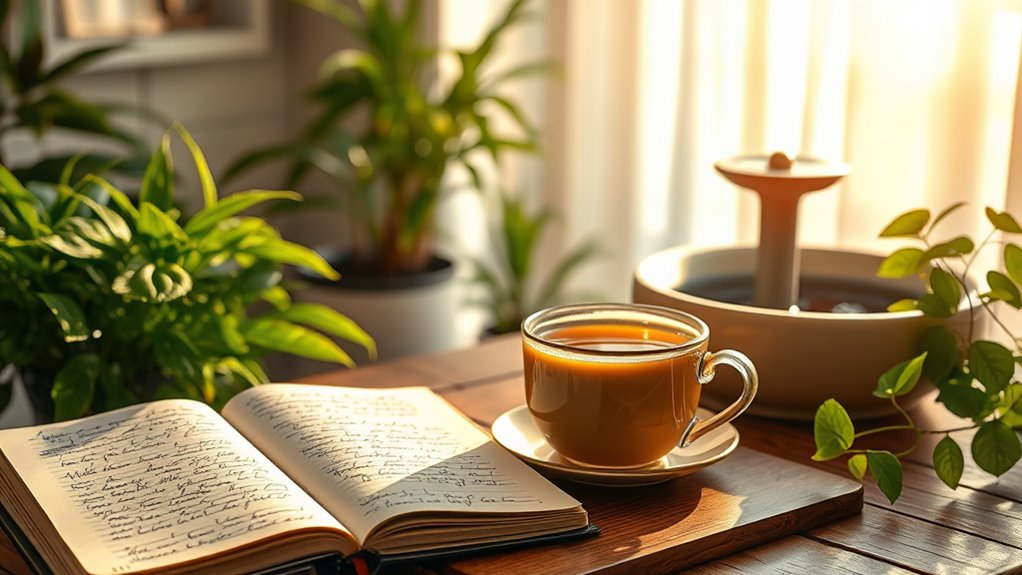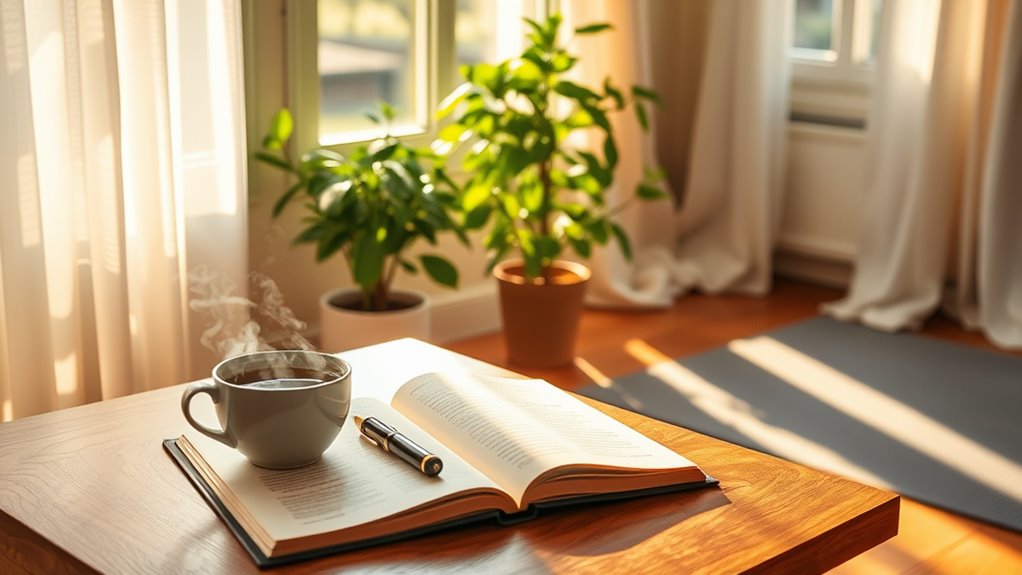How to Fall Asleep Faster With This 10-Minute Night Routine
To fall asleep faster, establish a consistent bedtime and create a relaxing environment to wind down. Limit screen time at least 30 minutes before sleep and practice deep breathing or light yoga to relax your mind and body. Sip on calming herbal tea like chamomile, write in a journal to clear your thoughts, and use aromatherapy with soothing scents. These simple steps can enhance your sleep quality, and there are more techniques to explore for even better results.
Key Takeaways
- Establish a consistent bedtime to regulate your body’s internal clock for easier sleep onset and better quality rest.
- Create a calming environment by dimming lights and ensuring a comfortable room temperature to promote relaxation.
- Limit screen time at least 30 minutes before bed and engage in calming activities like reading or journaling.
- Incorporate deep breathing exercises and gentle stretching to release tension and enhance mindfulness before sleep.
- Enjoy a cup of herbal tea, practice journaling, and use aromatherapy with calming essential oils to signal your body to wind down.
Set a Consistent Bedtime
When you set a consistent bedtime, you help regulate your body’s internal clock, making it easier to fall asleep. This consistency trains your mind and body to recognize when it’s time to wind down, promoting better sleep.
Aim to go to bed and wake up at the same time every day, even on weekends. This helps reinforce your natural sleep-wake cycle, leading to improved sleep quality.
You might also want to establish a pre-sleep routine—like reading or meditating—to signal to your body that it’s time to relax. Additionally, incorporating simple nighttime rituals can further enhance your ability to drift off to sleep peacefully.
Create a Relaxing Environment
To create a relaxing environment for sleep, start by dimming the lights in your room. A softer glow signals your body that it’s time to wind down. Additionally, controlling the room temperature can help you stay comfortable and promote a better night’s rest. Incorporating relaxation techniques into your pre-bedtime routine can further enhance your ability to fall asleep faster.
Dim the Lights
Creating a relaxing environment is essential for signaling your body that it’s time to wind down. One effective way to achieve this is by dimming the lights in your space. Soft lighting helps reduce stress and promotes melatonin production, making it easier to drift off. Consider using warm, low-intensity bulbs or lamps. Establishing a soothing bedtime routine can significantly enhance your sleep quality and lead to better sleep tonight.
| Lighting Type | Benefits | Tips |
|---|---|---|
| Candles | Creates a calming ambiance | Use unscented for better sleep |
| Fairy Lights | Soft, twinkling effect | Place them out of view |
| Dimmers | Adjustable brightness | Set to a warm tone |
Control Room Temperature
A comfortable room temperature can markedly impact how quickly you fall asleep. To create an ideal sleeping environment, consider these three key factors:
-
Optimal Temperature: Aim for a room temperature between 60-67°F (15-19°C). This range encourages your body to cool down, signaling it’s time for sleep.
-
Bedding Choices: Use breathable sheets and lightweight blankets. Natural fibers like cotton wick away moisture, keeping you cooler.
-
Ventilation: Maintain proper airflow by opening a window or using a fan. Fresh air circulation can help maintain consistency in temperature throughout the night. Additionally, prioritizing sleep is essential for overall quality of life, as it significantly contributes to physical health and mental well-being.
Limit Screen Time
As you wind down for the night, limiting screen time can greatly improve your chances of falling asleep faster.
The blue light emitted by devices like smartphones and tablets interferes with your body’s natural production of melatonin, the hormone responsible for regulating sleep.
Aim to disconnect from screens at least 30 minutes before bed. Instead of scrolling through social media or binge-watching shows, consider engaging in calming activities that help signal to your brain that it’s time to rest.
You might read a book, journal your thoughts, or listen to soothing music. Additionally, incorporating calming activities into your nighttime routine can further enhance your ability to relax and prepare for sleep.
Practice Deep Breathing
Unplugging from screens sets the stage for a restful night, but incorporating deep breathing techniques can further enhance your ability to fall asleep.
Deep breathing helps calm your mind and relax your body, making it easier to drift off. Here’s how to practice it effectively:
-
Find Your Position: Lie down comfortably on your back, arms at your sides. Confirm your environment is quiet and dimly lit.
-
Inhale Deeply: Take a slow, deep breath through your nose, counting to four. Feel your abdomen rise as you fill your lungs.
-
Exhale Slowly: Breathe out gently through your mouth for a count of six, letting go of tension.
Repeat this cycle for a few minutes, focusing solely on your breath to quiet your thoughts and embrace tranquility.
Stretch or Do Light Yoga
Stretching or doing light yoga can greatly ease your body and mind before bedtime.
These simple movements help release tension and promote relaxation, making it easier for you to fall asleep.
Let’s explore some beneficial stretches and yoga poses that can enhance your nighttime routine.
Benefits of Stretching
When you incorporate stretching or light yoga into your bedtime routine, you can greatly enhance your ability to unwind and prepare for sleep.
Here are three key benefits that make this practice essential:
-
Reduces Tension: Stretching helps release physical tension built up throughout the day, allowing your muscles to relax.
-
Improves Circulation: Gentle movements promote blood flow, which can help alleviate any stiffness and enhance your overall sense of well-being.
-
Calms the Mind: Focusing on your breath while stretching encourages mindfulness, helping to quiet racing thoughts and create a peaceful mindset conducive to sleep.
Simple Yoga Poses
Incorporating simple yoga poses into your bedtime routine can further enhance your relaxation process.
Start with Child’s Pose to release tension in your back and shoulders, grounding yourself in the moment.
Shift to Forward Bend, letting gravity pull you down and stretching your hamstrings, promoting a sense of calm.
Next, try Legs-Up-the-Wall Pose; it encourages blood circulation and soothes your nervous system.
Finish with Corpse Pose, where you lie flat, focusing on your breath, allowing your body to fully relax.
These poses not only ease physical stress but also quiet your mind, preparing you for restful sleep.
Remember to hold each pose for a few deep breaths, cultivating mindfulness and awareness.
This intentional practice can make a significant difference in your nightly routine.
Read a Book
Reading a book can be an excellent way to unwind after a long day, as it helps shift your focus away from daily stressors.
To make the most of your reading time, consider these three tips:
-
Choose the Right Genre: Opt for something that captivates you—whether it’s fiction, non-fiction, or poetry. The right book can transport you to another world.
-
Set a Dedicated Time: Carve out ten minutes before bed specifically for reading. Consistency helps create a calming routine.
-
Limit Screen Time: Avoid e-books or devices that emit blue light. Stick to physical books to enhance relaxation and improve your sleep quality.
Drink Herbal Tea
After winding down with a good book, sipping on a cup of herbal tea can further enhance your relaxation routine. Herbal teas, renowned for their calming properties, can help signal your body that it’s time to unwind. Chamomile, lavender, and peppermint are excellent choices, each promoting tranquility and preparing your mind for sleep.
| Tea Type | Benefits | Best Time to Consume |
|---|---|---|
| Chamomile | Reduces anxiety and enhances sleep | 30 minutes before bed |
| Lavender | Promotes relaxation and calmness | 30 minutes before bed |
| Peppermint | Aids digestion and relieves tension | Early evening |
Incorporating herbal tea into your nightly routine not only soothes your senses but also helps cultivate a peaceful mindset conducive to sleep.
Write in a Journal
Writing in a journal can be a powerful way to clear your mind and prepare for sleep. By putting your thoughts on paper, you create mental space, making it easier to unwind.
Here’s how to make the most of your journaling practice:
-
Reflect on your day: Summarize key events, accomplishments, and challenges. This helps you process experiences and emotions.
-
Express gratitude: Write down three things you’re grateful for. Focusing on positivity can shift your mindset and reduce stress.
-
Set intentions for tomorrow: Outline your goals or tasks for the next day. This fosters a sense of control, allowing you to let go of lingering worries.
In just a few minutes, journaling can transform your nightly routine and pave the way for restful sleep.
Use Aromatherapy
Aromatherapy can be a soothing addition to your bedtime routine, helping you relax and drift into a peaceful slumber.
Begin by choosing essential oils known for their calming properties, such as lavender, chamomile, or bergamot. You can diffuse these oils in your bedroom or apply them topically, diluted with a carrier oil.
As you prepare for sleep, take a moment to inhale the fragrance deeply, allowing it to envelop you. Consider adding a few drops to your pillow or bedding for an immersive experience.
This ritual not only signals your body that it’s time to wind down but also enhances your sleep quality. Mastering this technique can transform your nights, leading to quicker, more restorative sleep.
Reflect on Your Day
As you wind down from your day, taking a moment to reflect can help clear your mind and prepare you for sleep. This practice not only promotes relaxation but also enhances personal growth.
Here’s how to make the most of this reflection time:
-
Gratitude: Identify three things you’re thankful for today. This shifts your focus away from stress and encourages positivity.
-
Lessons Learned: Consider any challenges you faced. What did you learn? This cultivates resilience and prepares you for future hurdles.
-
Tomorrow’s Intentions: Set your intentions for the next day. What do you want to accomplish? This creates a sense of purpose and helps you sleep with a clear mind.
Incorporating this routine nightly can greatly enhance your overall well-being.
Frequently Asked Questions
How Long Should I Spend on Each Step of the Routine?
You think you need hours for each step? Not quite! Spend about two minutes on each, focusing on relaxation and mindfulness. This brevity helps you master the art of winding down efficiently and effectively.
Can I Customize the Routine to Fit My Preferences?
Absolutely, you can customize the routine to suit your preferences. Experiment with different activities, durations, and environments until you find what relaxes you most. Tailoring it will enhance your overall sleep experience and effectiveness.
What if I Don’T Have Time for a 10-Minute Routine?
If you don’t have time for a full routine, try incorporating even a few minutes of relaxation techniques, like deep breathing or stretching. Every little bit helps you unwind and prepares you for sleep.
Are There Specific Herbal Teas That Are Best for Sleep?
When it comes to sleep, “a stitch in time saves nine.” Chamomile, valerian root, and lavender teas can help you unwind. Brew a cup, sip slowly, and let the calming effects prepare you for restful slumber.
How Can I Maintain This Routine Long-Term?
To maintain your routine long-term, consistently evaluate its effectiveness, adjust as needed, and stay committed. Celebrate small victories, track progress, and remind yourself of the benefits to reinforce your dedication to a restful night.





